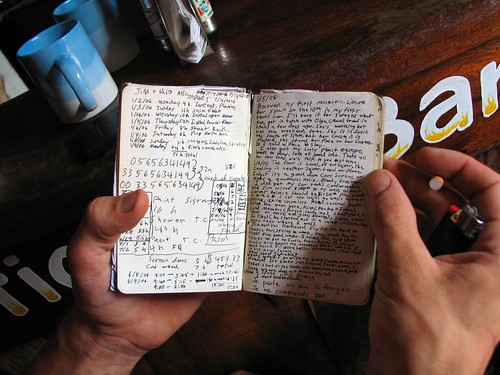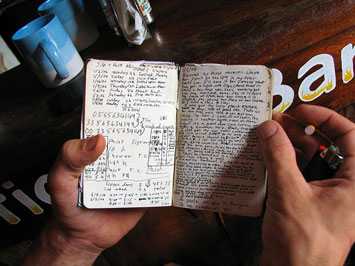Shelves full of spiral-bound notebooks filled with scrawl you’ll never open again? Or treasure troves of notes and experiences that you’ll re-read until your grandchildren hit college? If you’re planning to keep a journal while you’re traveling, you won’t be alone, but the big question is how to write one that you’ll actually want to read again.
Vagabondish is reader-supported. When you buy through links on our site, we may earn a small affiliate commission. Read our disclosure.
Some travelers swear by a laptop or an online blog to hold their memories, but this is not always practical, or in many cases not that desirable. When I travel, I still rely on my write-anywhere notebook and pen to record the special experiences I encounter.

Moleskine Travel Journal / © retro traveler
Tip 1: Pick an Attractive Book
This might seem superficial, but I bet the guy I met in a hostel in Vienna who was scribbling in a cheap school exercise book doesn’t open that up too often any more. I’ve always liked to buy a diary or notebook that’s a bit meaningful: in Slovakia, for example, I bought a hardcover notebook adorned with pictures of the pretty Bojnice Castle. I loved writing in it, probably wrote more than normal, and still like to grab it off my shelf today. Because we do judge a book by its cover, even if we wrote it ourselves.
Be careful to balance attractive with functional, though. In fact my favorite travel journals are spiral bound with thick, solid rings. They’re the easiest to open and lay flat while you write, or to balance on your lap or a tray in an airplane or train. Don’t be too cheap with it because this book’s going to get battered around on your travels, and you don’t want it falling apart.
Speaking of attractive: it might be a personal preference, or a completely neurotic habit, but I like to alternate the color of the pen I use each day. It’s more interesting to flip through, and easy to quickly locate where one day’s entry ends and another begins.
Tip 2: Weigh Your Words
Do not make the mistake of writing down every single thing that happens to you. Just because it’s happening in a foreign country doesn’t necessarily make it interesting, even to you.
I often want to remember practical facts from everyday life, like the number of the bus or the cost of a ticket, or even the series of stops my train makes. Instead of writing about this in long-winded prose, I make a few dot points of the salient facts and leave it at that. It’s also not necessary to list the chronology of your day, including how you got from X to Y: if it’s not interesting, leave it out. It usually won’t be that important in the future that you took a bus from the museum to the art gallery and it took 37 minutes.
Whenever you sit down to write in your journal, recall the sights or events of the last days that have made the biggest impression on you. Which special food did you eat, or how did you feel at a new museum? Try and paint a word picture describing your feelings and thoughts about your new experiences, as well as explaining the history or culture behind it. Talk about the different backgrounds of the locals or fellow travelers you’ve met, and why you like them (or not!).
Do make the effort to spend your first few words identifying the when and where. I always include a heading with both the day and date, plus the town I’m staying in, and the place where I’m writing the entry — the name of the hotel, a train line or a bench in a park.

© Elena777
Tip 3: The Original Multimedia Approach
Keep it interesting for your eyes by adding in the occasional tidbit that’s not just words. This might be a quick sketch to explain the bizarre arrangement of furniture in your current hotel room, or pasting in the train ticket with your name printed in the Cyrillic alphabet. My backpack always contains a pair of scissors and a small stick of glue, useful for many things but especially intended to help augment my travel journal.
Be creative about what the extra bits might be. When I traveled across Russia I bought the most delicious bag of wrapped candies in Irkutsk. I stuck one of these colorful candy wrappers into my journal and I can still taste them when I open to that page. At the same time, be selective about your extras, and don’t just stick in picture after picture from tourist brochures. Pick something meaningful.
Tip 4: Create an Index
I’m serious. While this might sound like an incredibly anally retentive thing to do, it works. Every time I get a new notebook to use as a travel diary (always an exciting moment), I sit down with a pen and number every page in the bottom corner. When the journal is full, I take a half hour to write an index that lists the main destinations of my trip and which page I can find them on. Later, when you want to re-read your journal, it will most often be because you want to check on the name of a museum you visited, or to find out the name of that friend you made in Beijing. You’ll be grateful for your handy index then.


